NISSAN FRONTIER 2018 Owner´s Manual
Manufacturer: NISSAN, Model Year: 2018, Model line: FRONTIER, Model: NISSAN FRONTIER 2018Pages: 502, PDF Size: 4.85 MB
Page 441 of 502
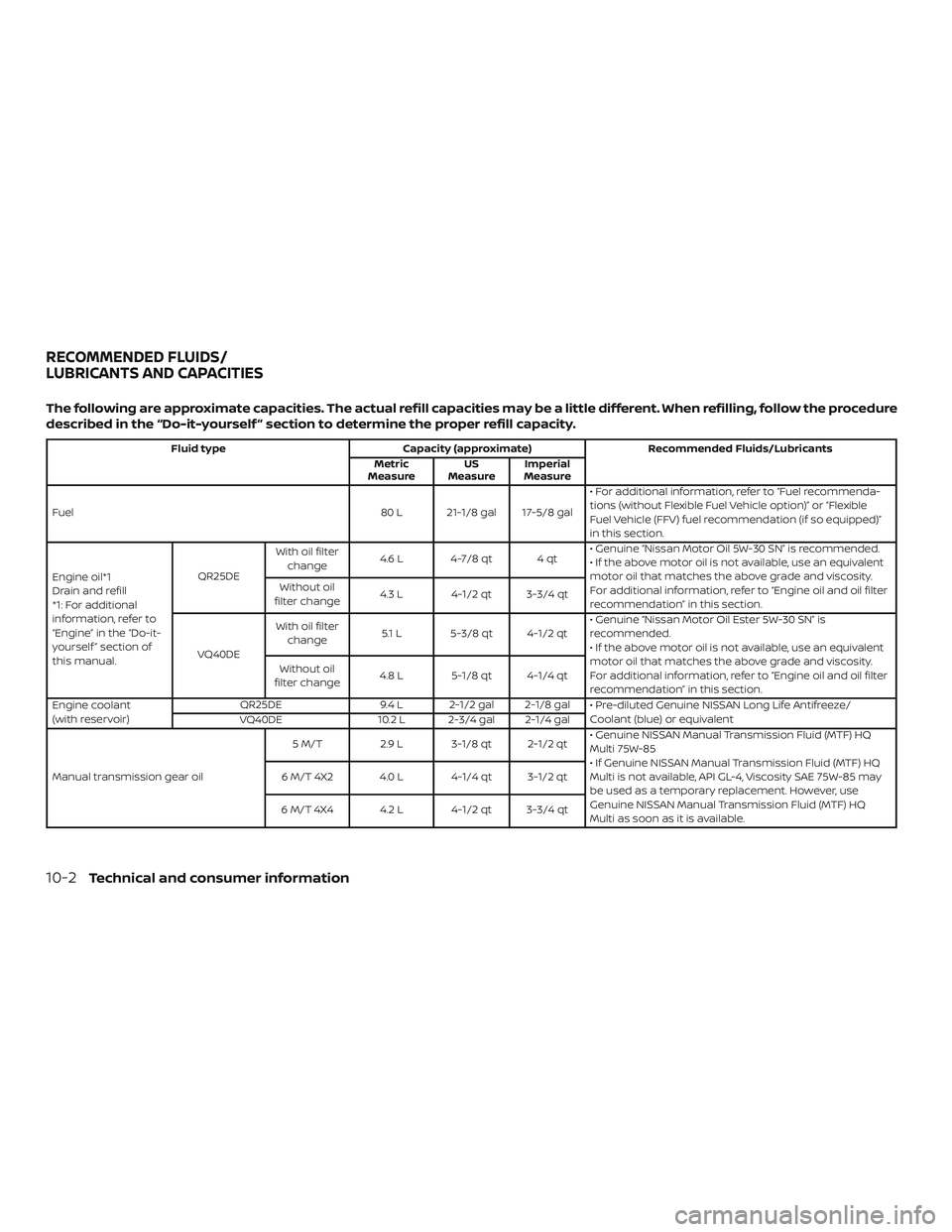
The following are approximate capacities. The actual refill capacities may be a little different. When refilling, follow the procedure
described in the “Do-it-yourself ” section to determine the proper refill capacity.
Fluid typeCapacity (approximate) Recommended Fluids/Lubricants
Metric
Measure US
Measure Imperial
Measure
Fuel 80 L 21-1/8 gal 17-5/8 gal• For additional information, refer to “Fuel recommenda-
tions (without Flexible Fuel Vehicle option)” or “Flexible
Fuel Vehicle (FFV) fuel recommendation (if so equipped)”
in this section.
Engine oil*1
Drain and refill
*1: For additional
information, refer to
“Engine” in the “Do-it-
yourself ” section of
this manual. QR25DE
With oil filter
change 4.6 L 4-7/8 qt 4 qt • Genuine “Nissan Motor Oil 5W-30 SN” is recommended.
• If the above motor oil is not available, use an equivalent
motor oil that matches the above grade and viscosity.
For additional information, refer to “Engine oil and oil filter
recommendation” in this section.
Without oil
filter change 4.3 L 4-1/2 qt 3-3/4 qt
VQ40DE With oil filter
change 5.1 L 5-3/8 qt 4-1/2 qt • Genuine “Nissan Motor Oil Ester 5W-30 SN” is
recommended.
• If the above motor oil is not available, use an equivalent
motor oil that matches the above grade and viscosity.
For additional information, refer to “Engine oil and oil filter
recommendation” in this section.
Without oil
filter change 4.8 L 5-1/8 qt 4-1/4 qt
Engine coolant
(with reservoir) QR25DE
9.4 L 2-1/2 gal 2-1/8 gal
• Pre-diluted Genuine NISSAN Long Life Antifreeze/
Coolant (blue) or equivalent
VQ40DE 10.2 L 2-3/4 gal 2-1/4 gal
Manual transmission gear oil 5 M/T
2.9 L 3-1/8 qt 2-1/2 qt • Genuine NISSAN Manual Transmission Fluid (MTF) HQ
Multi 75W-85
• If Genuine NISSAN Manual Transmission Fluid (MTF) HQ
Multi is not available, API GL-4, Viscosity SAE 75W-85 may
be used as a temporary replacement. However, use
Genuine NISSAN Manual Transmission Fluid (MTF) HQ
Multi as soon as it is available.
6 M/T 4X2 4.0 L 4-1/4 qt 3-1/2 qt
6 M/T 4X4 4.2 L 4-1/2 qt 3-3/4 qt
RECOMMENDED FLUIDS/
LUBRICANTS AND CAPACITIES
10-2Technical and consumer information
Page 442 of 502
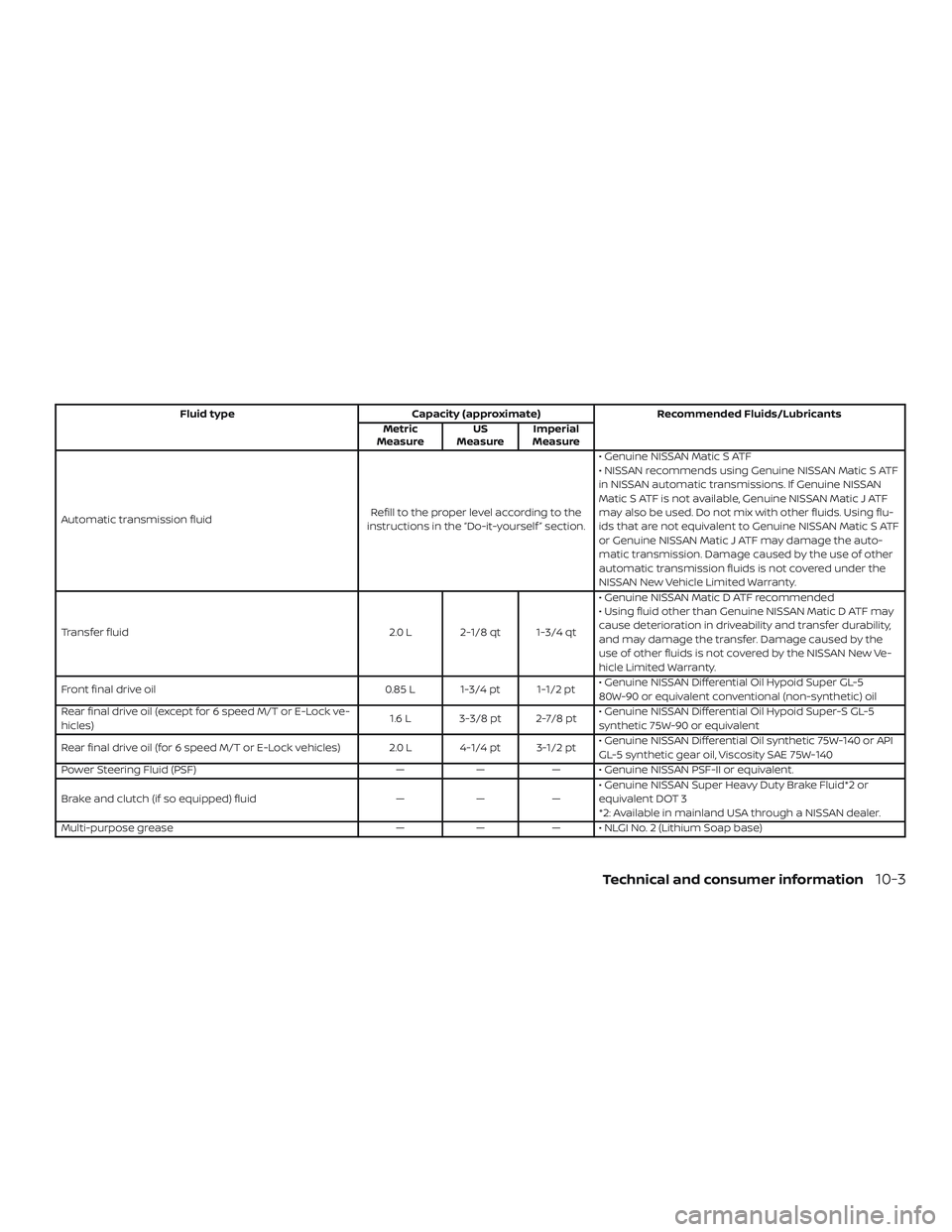
Fluid typeCapacity (approximate) Recommended Fluids/Lubricants
Metric
Measure US
Measure Imperial
Measure
Automatic transmission fluid Refill to the proper level according to the
instructions in the “Do-it-yourself ” section. • Genuine NISSAN Matic S ATF
• NISSAN recommends using Genuine NISSAN Matic S ATF
in NISSAN automatic transmissions. If Genuine NISSAN
Matic S ATF is not available, Genuine NISSAN Matic J ATF
may also be used. Do not mix with other fluids. Using flu-
ids that are not equivalent to Genuine NISSAN Matic S ATF
or Genuine NISSAN Matic J ATF may damage the auto-
matic transmission. Damage caused by the use of other
automatic transmission fluids is not covered under the
NISSAN New Vehicle Limited Warranty.
Transfer fluid 2.0 L 2-1/8 qt 1-3/4 qt• Genuine NISSAN Matic D ATF recommended
• Using fluid other than Genuine NISSAN Matic D ATF may
cause deterioration in driveability and transfer durability,
and may damage the transfer. Damage caused by the
use of other fluids is not covered by the NISSAN New Ve-
hicle Limited Warranty.
Front final drive oil 0.85 L 1-3/4 pt 1-1/2 pt• Genuine NISSAN Differential Oil Hypoid Super GL-5
80W-90 or equivalent conventional (non-synthetic) oil
Rear final drive oil (except for 6 speed M/T or E-Lock ve-
hicles) 1.6 L 3-3/8 pt 2-7/8 pt• Genuine NISSAN Differential Oil Hypoid Super-S GL-5
synthetic 75W-90 or equivalent
Rear final drive oil (for 6 speed M/T or E-Lock vehicles) 2.0 L 4-1/4 pt 3-1/2 pt • Genuine NISSAN Differential Oil synthetic 75W-140 or API
GL-5 synthetic gear oil, Viscosity SAE 75W-140
Power Steering Fluid (PSF) ——— • Genuine NISSAN PSF-II or equivalent.
Brake and clutch (if so equipped) fluid ———• Genuine NISSAN Super Heavy Duty Brake Fluid*2 or
equivalent DOT 3
*2: Available in mainland USA through a NISSAN dealer.
Multi-purpose grease ——— • NLGI No. 2 (Lithium Soap base)
Technical and consumer information10-3
Page 443 of 502
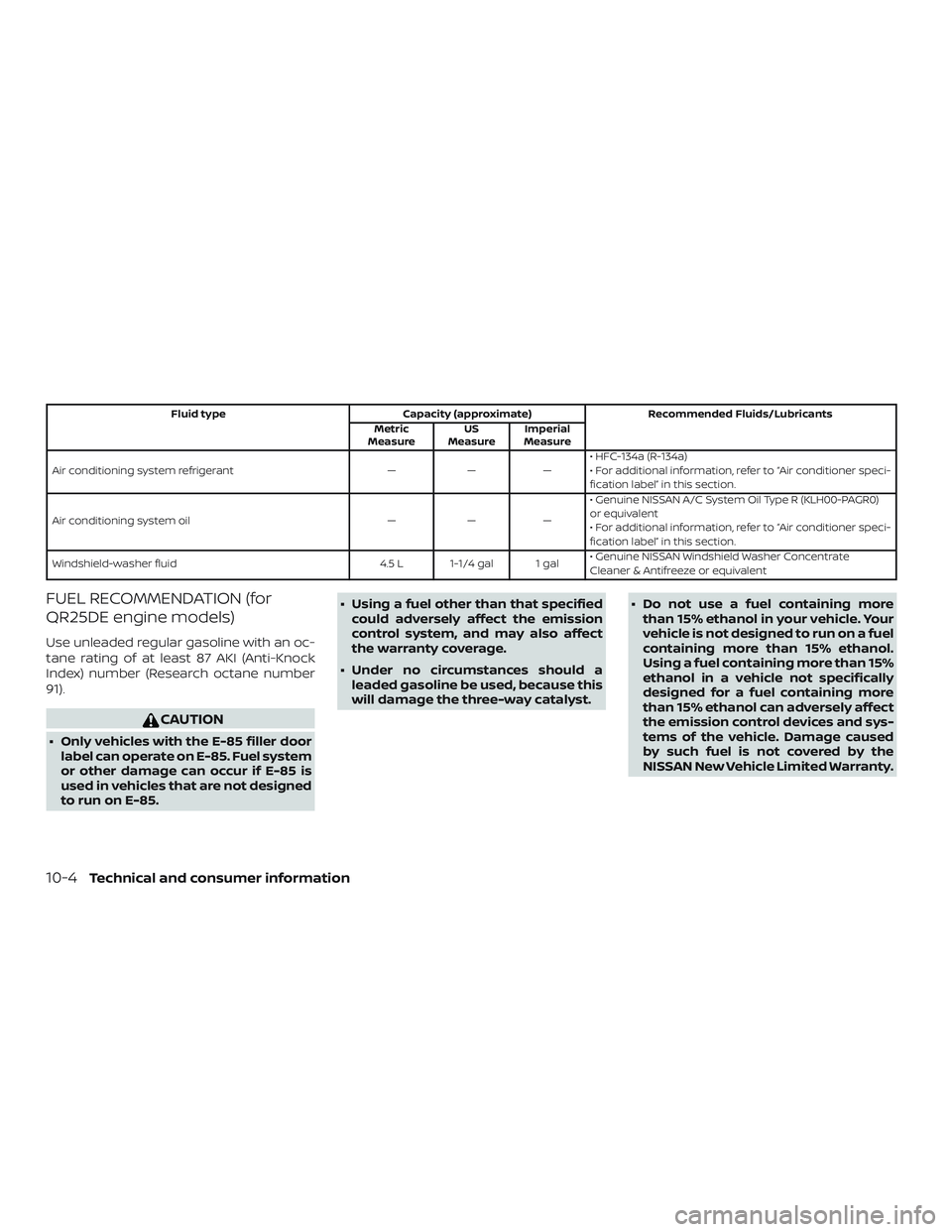
Fluid typeCapacity (approximate) Recommended Fluids/Lubricants
Metric
Measure US
Measure Imperial
Measure
Air conditioning system refrigerant ———• HFC-134a (R-134a)
• For additional information, refer to “Air conditioner speci-
fication label” in this section.
Air conditioning system oil ———• Genuine NISSAN A/C System Oil Type R (KLH00-PAGR0)
or equivalent
• For additional information, refer to “Air conditioner speci-
fication label” in this section.
Windshield-washer fluid 4.5 L 1-1/4 gal 1 gal• Genuine NISSAN Windshield Washer Concentrate
Cleaner & Antifreeze or equivalent
FUEL RECOMMENDATION (for
QR25DE engine models)
Use unleaded regular gasoline with an oc-
tane rating of at least 87 AKI (Anti-Knock
Index) number (Research octane number
91).
CAUTION
∙ Only vehicles with the E-85 filler door
label can operate on E-85. Fuel system
or other damage can occur if E-85 is
used in vehicles that are not designed
to run on E-85. ∙ Using a fuel other than that specified
could adversely affect the emission
control system, and may also affect
the warranty coverage.
∙ Under no circumstances should a leaded gasoline be used, because this
will damage the three-way catalyst. ∙ Do not use a fuel containing more
than 15% ethanol in your vehicle. Your
vehicle is not designed to run on a fuel
containing more than 15% ethanol.
Using a fuel containing more than 15%
ethanol in a vehicle not specifically
designed for a fuel containing more
than 15% ethanol can adversely affect
the emission control devices and sys-
tems of the vehicle. Damage caused
by such fuel is not covered by the
NISSAN New Vehicle Limited Warranty.
10-4Technical and consumer information
Page 444 of 502
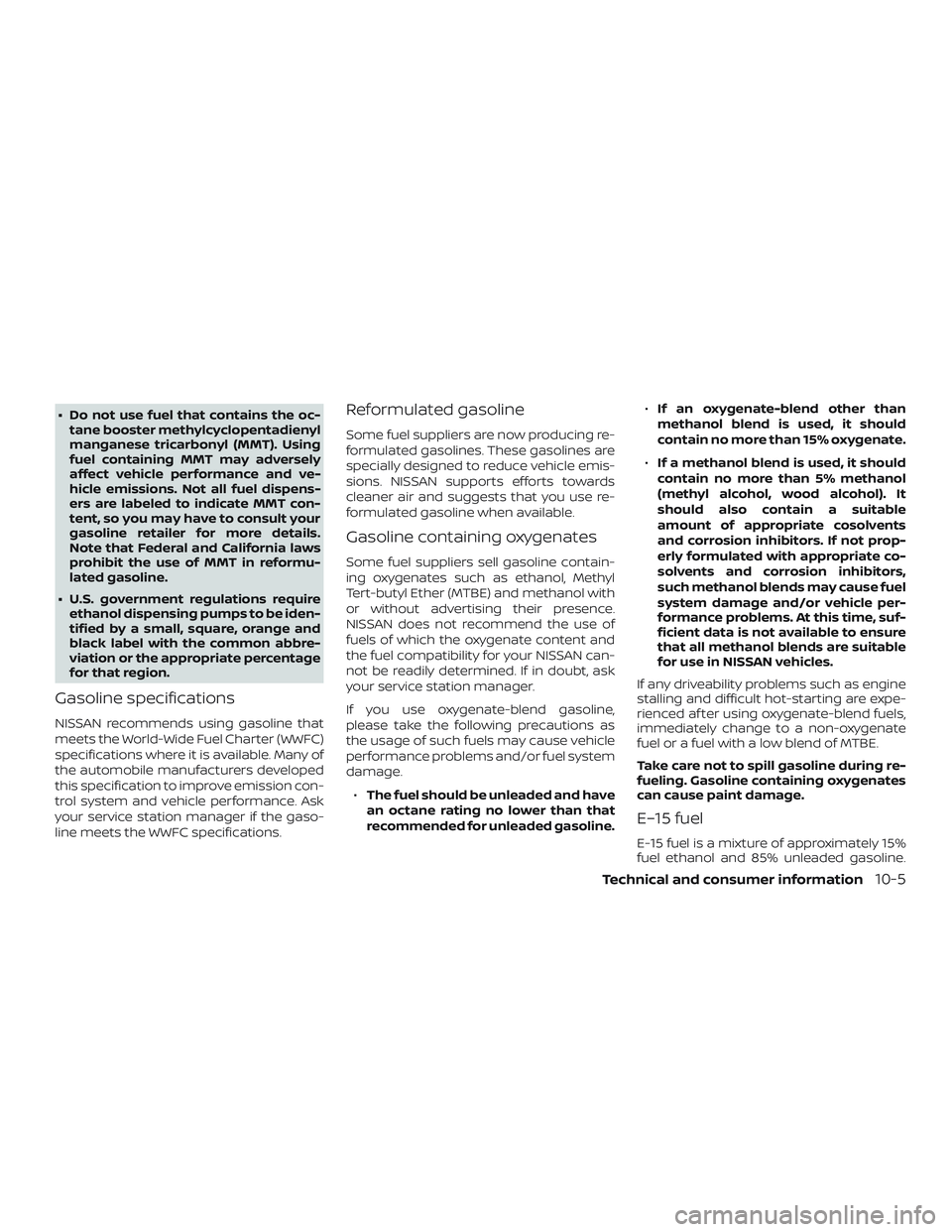
∙ Do not use fuel that contains the oc-tane booster methylcyclopentadienyl
manganese tricarbonyl (MMT). Using
fuel containing MMT may adversely
affect vehicle performance and ve-
hicle emissions. Not all fuel dispens-
ers are labeled to indicate MMT con-
tent, so you may have to consult your
gasoline retailer for more details.
Note that Federal and California laws
prohibit the use of MMT in reformu-
lated gasoline.
∙ U.S. government regulations require ethanol dispensing pumps to be iden-
tified by a small, square, orange and
black label with the common abbre-
viation or the appropriate percentage
for that region.
Gasoline specifications
NISSAN recommends using gasoline that
meets the World-Wide Fuel Charter (WWFC)
specifications where it is available. Many of
the automobile manufacturers developed
this specification to improve emission con-
trol system and vehicle performance. Ask
your service station manager if the gaso-
line meets the WWFC specifications.
Reformulated gasoline
Some fuel suppliers are now producing re-
formulated gasolines. These gasolines are
specially designed to reduce vehicle emis-
sions. NISSAN supports efforts towards
cleaner air and suggests that you use re-
formulated gasoline when available.
Gasoline containing oxygenates
Some fuel suppliers sell gasoline contain-
ing oxygenates such as ethanol, Methyl
Tert-butyl Ether (MTBE) and methanol with
or without advertising their presence.
NISSAN does not recommend the use of
fuels of which the oxygenate content and
the fuel compatibility for your NISSAN can-
not be readily determined. If in doubt, ask
your service station manager.
If you use oxygenate-blend gasoline,
please take the following precautions as
the usage of such fuels may cause vehicle
performance problems and/or fuel system
damage.
∙ The fuel should be unleaded and have
an octane rating no lower than that
recommended for unleaded gasoline. ∙
If an oxygenate-blend other than
methanol blend is used, it should
contain no more than 15% oxygenate.
∙ If a methanol blend is used, it should
contain no more than 5% methanol
(methyl alcohol, wood alcohol). It
should also contain a suitable
amount of appropriate cosolvents
and corrosion inhibitors. If not prop-
erly formulated with appropriate co-
solvents and corrosion inhibitors,
such methanol blends may cause fuel
system damage and/or vehicle per-
formance problems. At this time, suf-
ficient data is not available to ensure
that all methanol blends are suitable
for use in NISSAN vehicles.
If any driveability problems such as engine
stalling and difficult hot-starting are expe-
rienced af ter using oxygenate-blend fuels,
immediately change to a non-oxygenate
fuel or a fuel with a low blend of MTBE.
Take care not to spill gasoline during re-
fueling. Gasoline containing oxygenates
can cause paint damage.
E–15 fuel
E-15 fuel is a mixture of approximately 15%
fuel ethanol and 85% unleaded gasoline.
Technical and consumer information10-5
Page 445 of 502
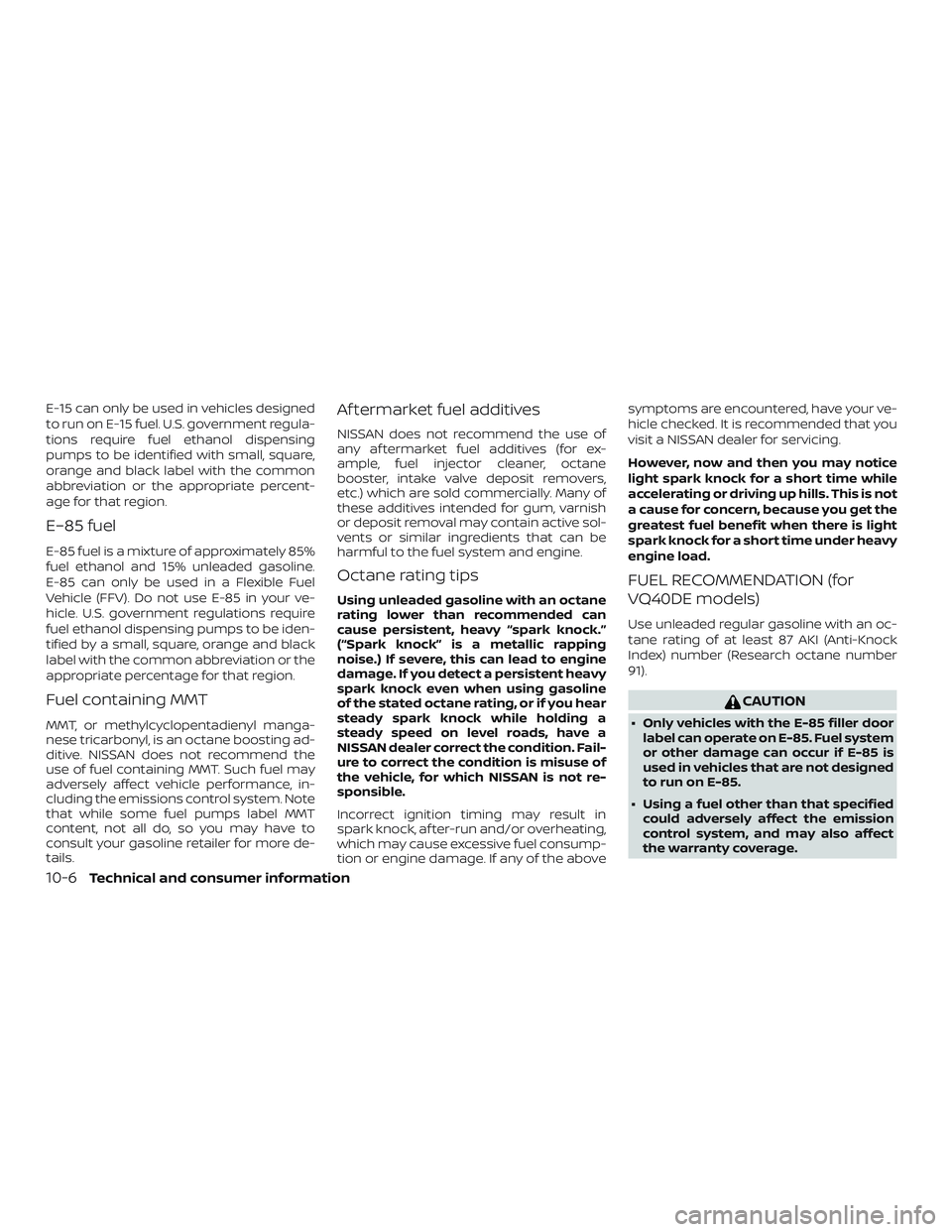
E-15 can only be used in vehicles designed
to run on E-15 fuel. U.S. government regula-
tions require fuel ethanol dispensing
pumps to be identified with small, square,
orange and black label with the common
abbreviation or the appropriate percent-
age for that region.
E–85 fuel
E-85 fuel is a mixture of approximately 85%
fuel ethanol and 15% unleaded gasoline.
E-85 can only be used in a Flexible Fuel
Vehicle (FFV). Do not use E-85 in your ve-
hicle. U.S. government regulations require
fuel ethanol dispensing pumps to be iden-
tified by a small, square, orange and black
label with the common abbreviation or the
appropriate percentage for that region.
Fuel containing MMT
MMT, or methylcyclopentadienyl manga-
nese tricarbonyl, is an octane boosting ad-
ditive. NISSAN does not recommend the
use of fuel containing MMT. Such fuel may
adversely affect vehicle performance, in-
cluding the emissions control system. Note
that while some fuel pumps label MMT
content, not all do, so you may have to
consult your gasoline retailer for more de-
tails.
Af termarket fuel additives
NISSAN does not recommend the use of
any af termarket fuel additives (for ex-
ample, fuel injector cleaner, octane
booster, intake valve deposit removers,
etc.) which are sold commercially. Many of
these additives intended for gum, varnish
or deposit removal may contain active sol-
vents or similar ingredients that can be
harmful to the fuel system and engine.
Octane rating tips
Using unleaded gasoline with an octane
rating lower than recommended can
cause persistent, heavy “spark knock.”
(“Spark knock” is a metallic rapping
noise.) If severe, this can lead to engine
damage. If you detect a persistent heavy
spark knock even when using gasoline
of the stated octane rating, or if you hear
steady spark knock while holding a
steady speed on level roads, have a
NISSAN dealer correct the condition. Fail-
ure to correct the condition is misuse of
the vehicle, for which NISSAN is not re-
sponsible.
Incorrect ignition timing may result in
spark knock, af ter-run and/or overheating,
which may cause excessive fuel consump-
tion or engine damage. If any of the abovesymptoms are encountered, have your ve-
hicle checked. It is recommended that you
visit a NISSAN dealer for servicing.
However, now and then you may notice
light spark knock for a short time while
accelerating or driving up hills. This is not
a cause for concern, because you get the
greatest fuel benefit when there is light
spark knock for a short time under heavy
engine load.
FUEL RECOMMENDATION (for
VQ40DE models)
Use unleaded regular gasoline with an oc-
tane rating of at least 87 AKI (Anti-Knock
Index) number (Research octane number
91).
CAUTION
∙ Only vehicles with the E-85 filler door
label can operate on E-85. Fuel system
or other damage can occur if E-85 is
used in vehicles that are not designed
to run on E-85.
∙ Using a fuel other than that specified could adversely affect the emission
control system, and may also affect
the warranty coverage.
10-6Technical and consumer information
Page 446 of 502
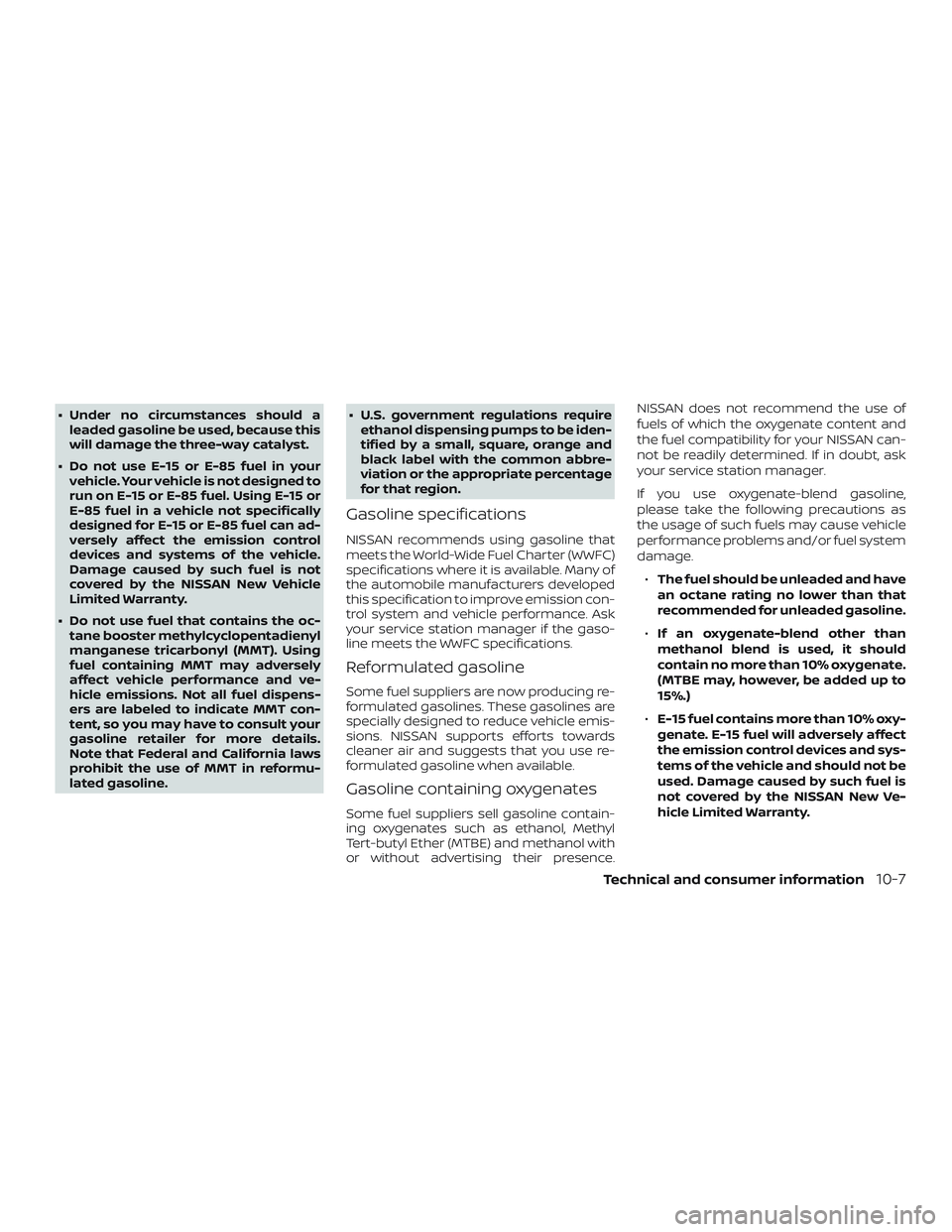
∙ Under no circumstances should aleaded gasoline be used, because this
will damage the three-way catalyst.
∙ Do not use E-15 or E-85 fuel in your vehicle. Your vehicle is not designed to
run on E-15 or E-85 fuel. Using E-15 or
E-85 fuel in a vehicle not specifically
designed for E-15 or E-85 fuel can ad-
versely affect the emission control
devices and systems of the vehicle.
Damage caused by such fuel is not
covered by the NISSAN New Vehicle
Limited Warranty.
∙ Do not use fuel that contains the oc- tane booster methylcyclopentadienyl
manganese tricarbonyl (MMT). Using
fuel containing MMT may adversely
affect vehicle performance and ve-
hicle emissions. Not all fuel dispens-
ers are labeled to indicate MMT con-
tent, so you may have to consult your
gasoline retailer for more details.
Note that Federal and California laws
prohibit the use of MMT in reformu-
lated gasoline. ∙ U.S. government regulations require
ethanol dispensing pumps to be iden-
tified by a small, square, orange and
black label with the common abbre-
viation or the appropriate percentage
for that region.
Gasoline specifications
NISSAN recommends using gasoline that
meets the World-Wide Fuel Charter (WWFC)
specifications where it is available. Many of
the automobile manufacturers developed
this specification to improve emission con-
trol system and vehicle performance. Ask
your service station manager if the gaso-
line meets the WWFC specifications.
Reformulated gasoline
Some fuel suppliers are now producing re-
formulated gasolines. These gasolines are
specially designed to reduce vehicle emis-
sions. NISSAN supports efforts towards
cleaner air and suggests that you use re-
formulated gasoline when available.
Gasoline containing oxygenates
Some fuel suppliers sell gasoline contain-
ing oxygenates such as ethanol, Methyl
Tert-butyl Ether (MTBE) and methanol with
or without advertising their presence. NISSAN does not recommend the use of
fuels of which the oxygenate content and
the fuel compatibility for your NISSAN can-
not be readily determined. If in doubt, ask
your service station manager.
If you use oxygenate-blend gasoline,
please take the following precautions as
the usage of such fuels may cause vehicle
performance problems and/or fuel system
damage.
∙ The fuel should be unleaded and have
an octane rating no lower than that
recommended for unleaded gasoline.
∙ If an oxygenate-blend other than
methanol blend is used, it should
contain no more than 10% oxygenate.
(MTBE may, however, be added up to
15%.)
∙ E-15 fuel contains more than 10% oxy-
genate. E-15 fuel will adversely affect
the emission control devices and sys-
tems of the vehicle and should not be
used. Damage caused by such fuel is
not covered by the NISSAN New Ve-
hicle Limited Warranty.
Technical and consumer information10-7
Page 447 of 502
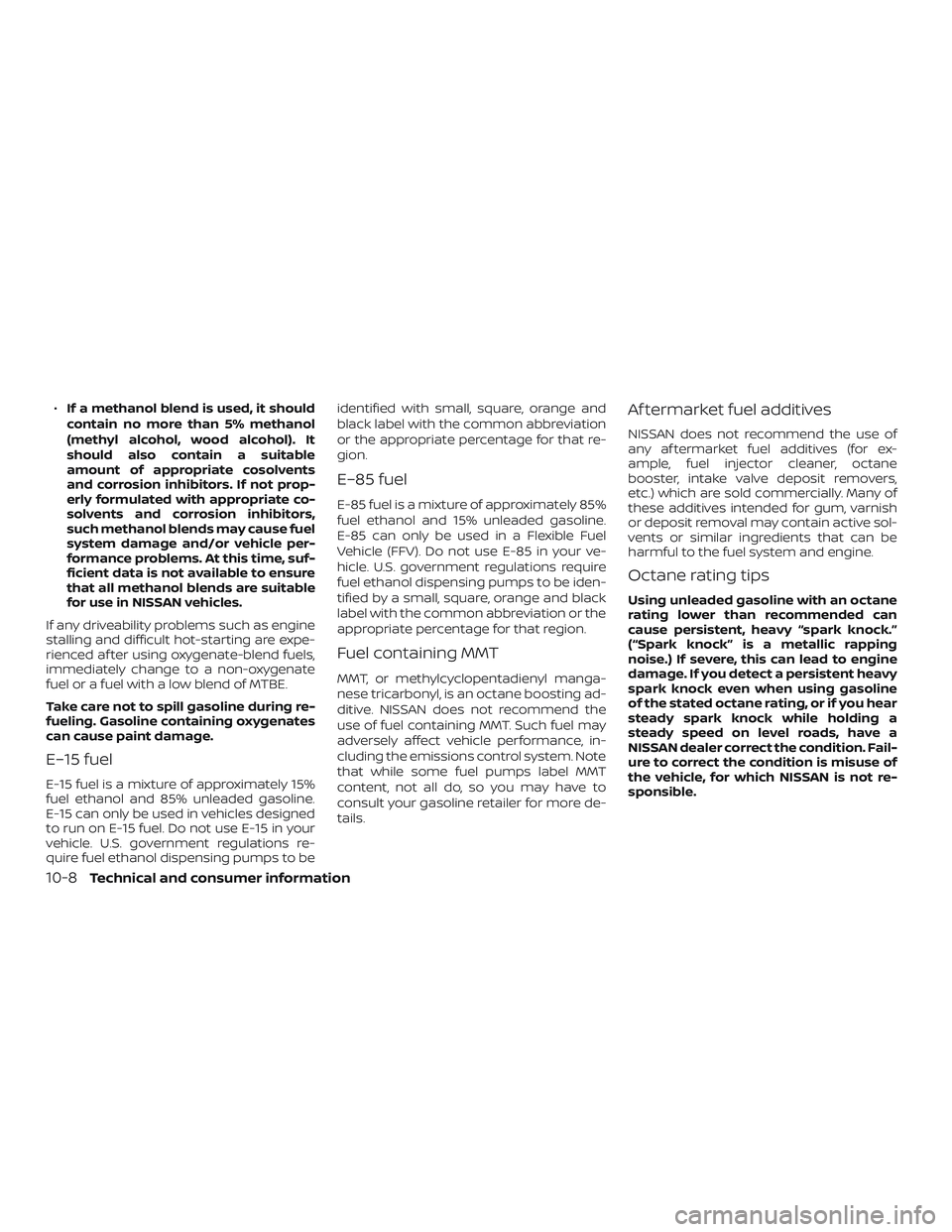
∙If a methanol blend is used, it should
contain no more than 5% methanol
(methyl alcohol, wood alcohol). It
should also contain a suitable
amount of appropriate cosolvents
and corrosion inhibitors. If not prop-
erly formulated with appropriate co-
solvents and corrosion inhibitors,
such methanol blends may cause fuel
system damage and/or vehicle per-
formance problems. At this time, suf-
ficient data is not available to ensure
that all methanol blends are suitable
for use in NISSAN vehicles.
If any driveability problems such as engine
stalling and difficult hot-starting are expe-
rienced af ter using oxygenate-blend fuels,
immediately change to a non-oxygenate
fuel or a fuel with a low blend of MTBE.
Take care not to spill gasoline during re-
fueling. Gasoline containing oxygenates
can cause paint damage.
E–15 fuel
E-15 fuel is a mixture of approximately 15%
fuel ethanol and 85% unleaded gasoline.
E-15 can only be used in vehicles designed
to run on E-15 fuel. Do not use E-15 in your
vehicle. U.S. government regulations re-
quire fuel ethanol dispensing pumps to be identified with small, square, orange and
black label with the common abbreviation
or the appropriate percentage for that re-
gion.
E–85 fuel
E-85 fuel is a mixture of approximately 85%
fuel ethanol and 15% unleaded gasoline.
E-85 can only be used in a Flexible Fuel
Vehicle (FFV). Do not use E-85 in your ve-
hicle. U.S. government regulations require
fuel ethanol dispensing pumps to be iden-
tified by a small, square, orange and black
label with the common abbreviation or the
appropriate percentage for that region.
Fuel containing MMT
MMT, or methylcyclopentadienyl manga-
nese tricarbonyl, is an octane boosting ad-
ditive. NISSAN does not recommend the
use of fuel containing MMT. Such fuel may
adversely affect vehicle performance, in-
cluding the emissions control system. Note
that while some fuel pumps label MMT
content, not all do, so you may have to
consult your gasoline retailer for more de-
tails.
Af termarket fuel additives
NISSAN does not recommend the use of
any af termarket fuel additives (for ex-
ample, fuel injector cleaner, octane
booster, intake valve deposit removers,
etc.) which are sold commercially. Many of
these additives intended for gum, varnish
or deposit removal may contain active sol-
vents or similar ingredients that can be
harmful to the fuel system and engine.
Octane rating tips
Using unleaded gasoline with an octane
rating lower than recommended can
cause persistent, heavy “spark knock.”
(“Spark knock” is a metallic rapping
noise.) If severe, this can lead to engine
damage. If you detect a persistent heavy
spark knock even when using gasoline
of the stated octane rating, or if you hear
steady spark knock while holding a
steady speed on level roads, have a
NISSAN dealer correct the condition. Fail-
ure to correct the condition is misuse of
the vehicle, for which NISSAN is not re-
sponsible.
10-8Technical and consumer information
Page 448 of 502
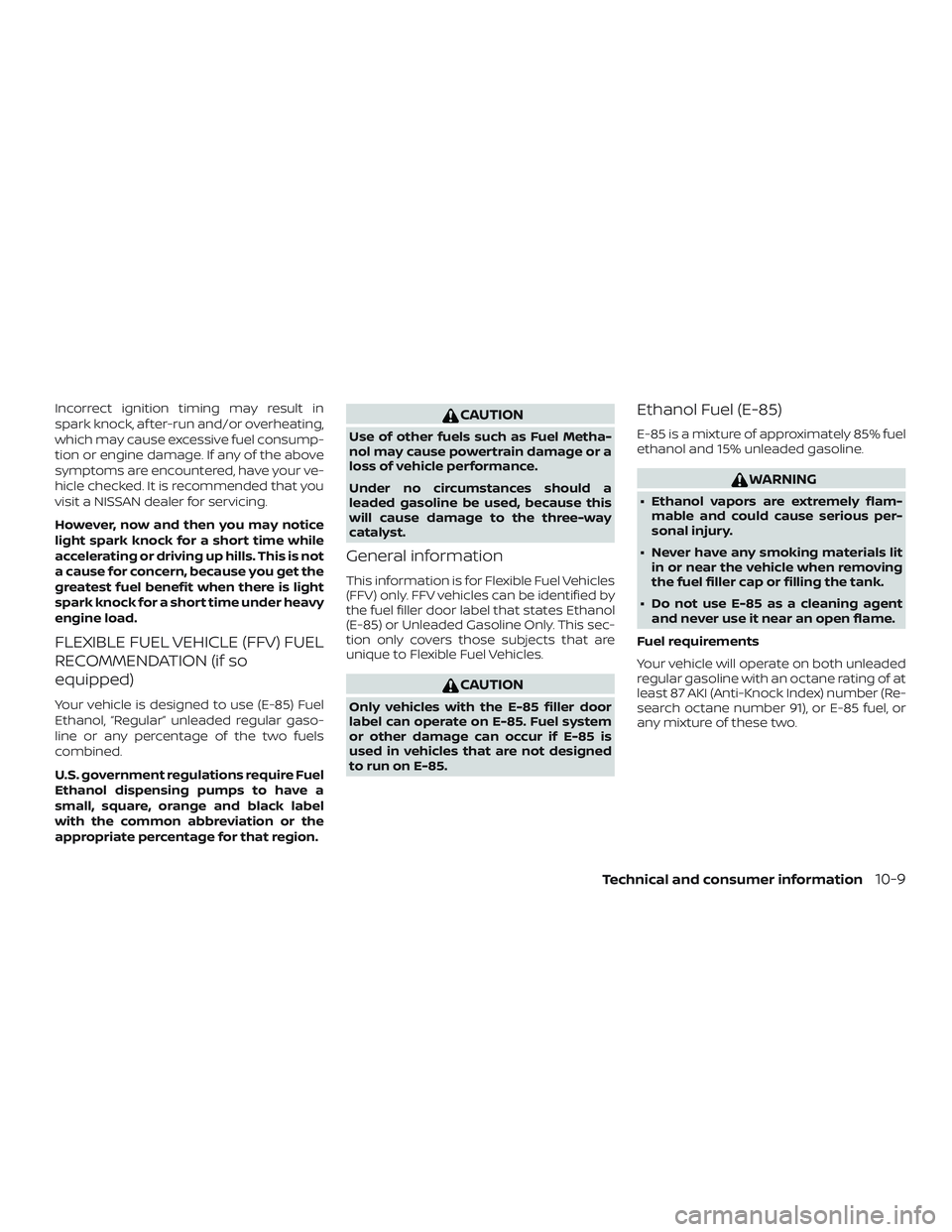
Incorrect ignition timing may result in
spark knock, af ter-run and/or overheating,
which may cause excessive fuel consump-
tion or engine damage. If any of the above
symptoms are encountered, have your ve-
hicle checked. It is recommended that you
visit a NISSAN dealer for servicing.
However, now and then you may notice
light spark knock for a short time while
accelerating or driving up hills. This is not
a cause for concern, because you get the
greatest fuel benefit when there is light
spark knock for a short time under heavy
engine load.
FLEXIBLE FUEL VEHICLE (FFV) FUEL
RECOMMENDATION (if so
equipped)
Your vehicle is designed to use (E-85) Fuel
Ethanol, “Regular” unleaded regular gaso-
line or any percentage of the two fuels
combined.
U.S. government regulations require Fuel
Ethanol dispensing pumps to have a
small, square, orange and black label
with the common abbreviation or the
appropriate percentage for that region.
CAUTION
Use of other fuels such as Fuel Metha-
nol may cause powertrain damage or a
loss of vehicle performance.
Under no circumstances should a
leaded gasoline be used, because this
will cause damage to the three-way
catalyst.
General information
This information is for Flexible Fuel Vehicles
(FFV) only. FFV vehicles can be identified by
the fuel filler door label that states Ethanol
(E-85) or Unleaded Gasoline Only. This sec-
tion only covers those subjects that are
unique to Flexible Fuel Vehicles.
CAUTION
Only vehicles with the E-85 filler door
label can operate on E-85. Fuel system
or other damage can occur if E-85 is
used in vehicles that are not designed
to run on E-85.
Ethanol Fuel (E-85)
E-85 is a mixture of approximately 85% fuel
ethanol and 15% unleaded gasoline.
WARNING
∙ Ethanol vapors are extremely flam-mable and could cause serious per-
sonal injury.
∙ Never have any smoking materials lit in or near the vehicle when removing
the fuel filler cap or filling the tank.
∙ Do not use E-85 as a cleaning agent and never use it near an open flame.
Fuel requirements
Your vehicle will operate on both unleaded
regular gasoline with an octane rating of at
least 87 AKI (Anti-Knock Index) number (Re-
search octane number 91), or E-85 fuel, or
any mixture of these two.
Technical and consumer information10-9
Page 449 of 502
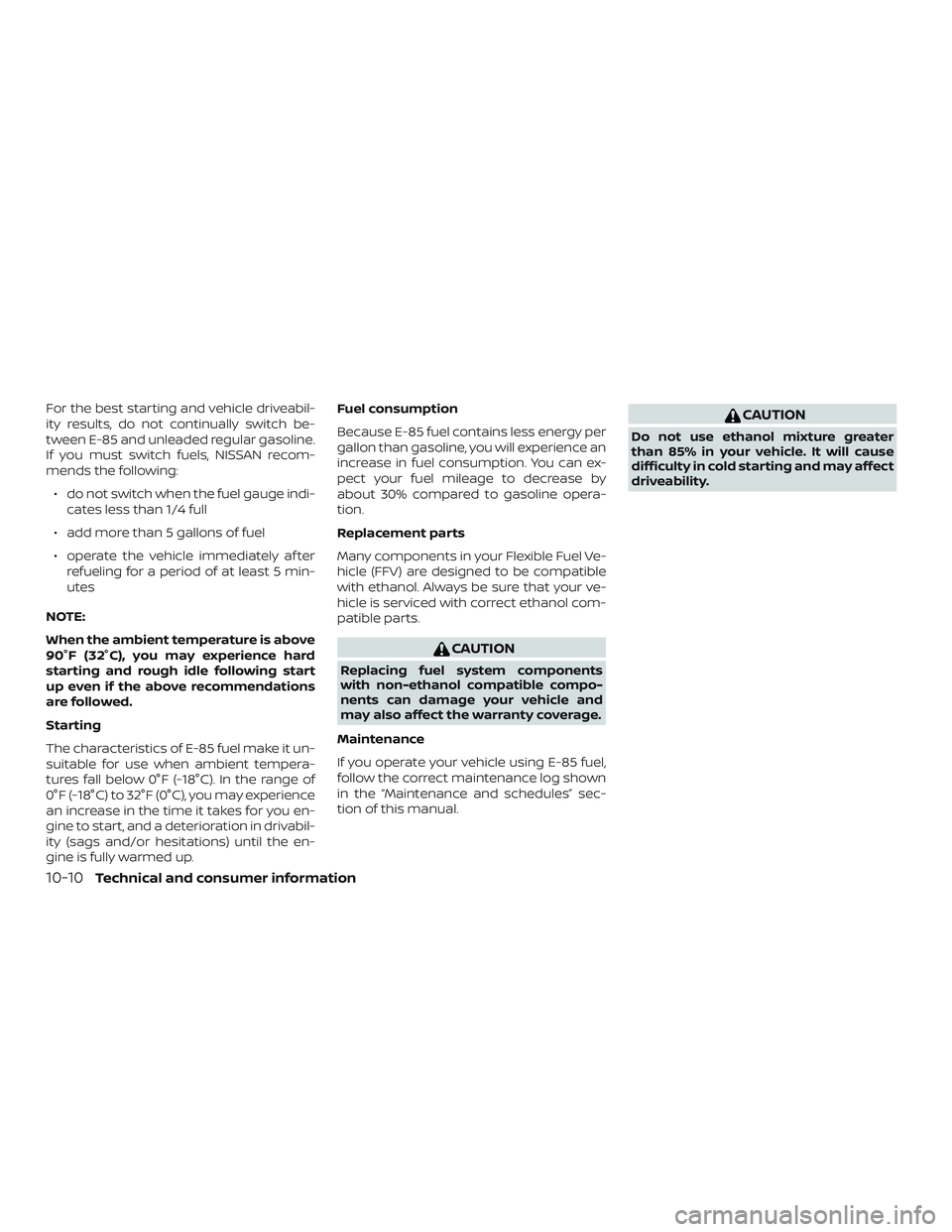
For the best starting and vehicle driveabil-
ity results, do not continually switch be-
tween E-85 and unleaded regular gasoline.
If you must switch fuels, NISSAN recom-
mends the following:∙ do not switch when the fuel gauge indi- cates less than 1/4 full
∙ add more than 5 gallons of fuel
∙ operate the vehicle immediately af ter refueling for a period of at least 5 min-
utes
NOTE:
When the ambient temperature is above
90°F (32°C), you may experience hard
starting and rough idle following start
up even if the above recommendations
are followed.
Starting
The characteristics of E-85 fuel make it un-
suitable for use when ambient tempera-
tures fall below 0°F (-18°C). In the range of
0°F (-18°C) to 32°F (0°C), you may experience
an increase in the time it takes for you en-
gine to start, and a deterioration in drivabil-
ity (sags and/or hesitations) until the en-
gine is fully warmed up. Fuel consumption
Because E-85 fuel contains less energy per
gallon than gasoline, you will experience an
increase in fuel consumption. You can ex-
pect your fuel mileage to decrease by
about 30% compared to gasoline opera-
tion.
Replacement parts
Many components in your Flexible Fuel Ve-
hicle (FFV) are designed to be compatible
with ethanol. Always be sure that your ve-
hicle is serviced with correct ethanol com-
patible parts.
CAUTION
Replacing fuel system components
with non-ethanol compatible compo-
nents can damage your vehicle and
may also affect the warranty coverage.
Maintenance
If you operate your vehicle using E-85 fuel,
follow the correct maintenance log shown
in the “Maintenance and schedules” sec-
tion of this manual.
CAUTION
Do not use ethanol mixture greater
than 85% in your vehicle. It will cause
difficulty in cold starting and may affect
driveability.
10-10Technical and consumer information
Page 450 of 502
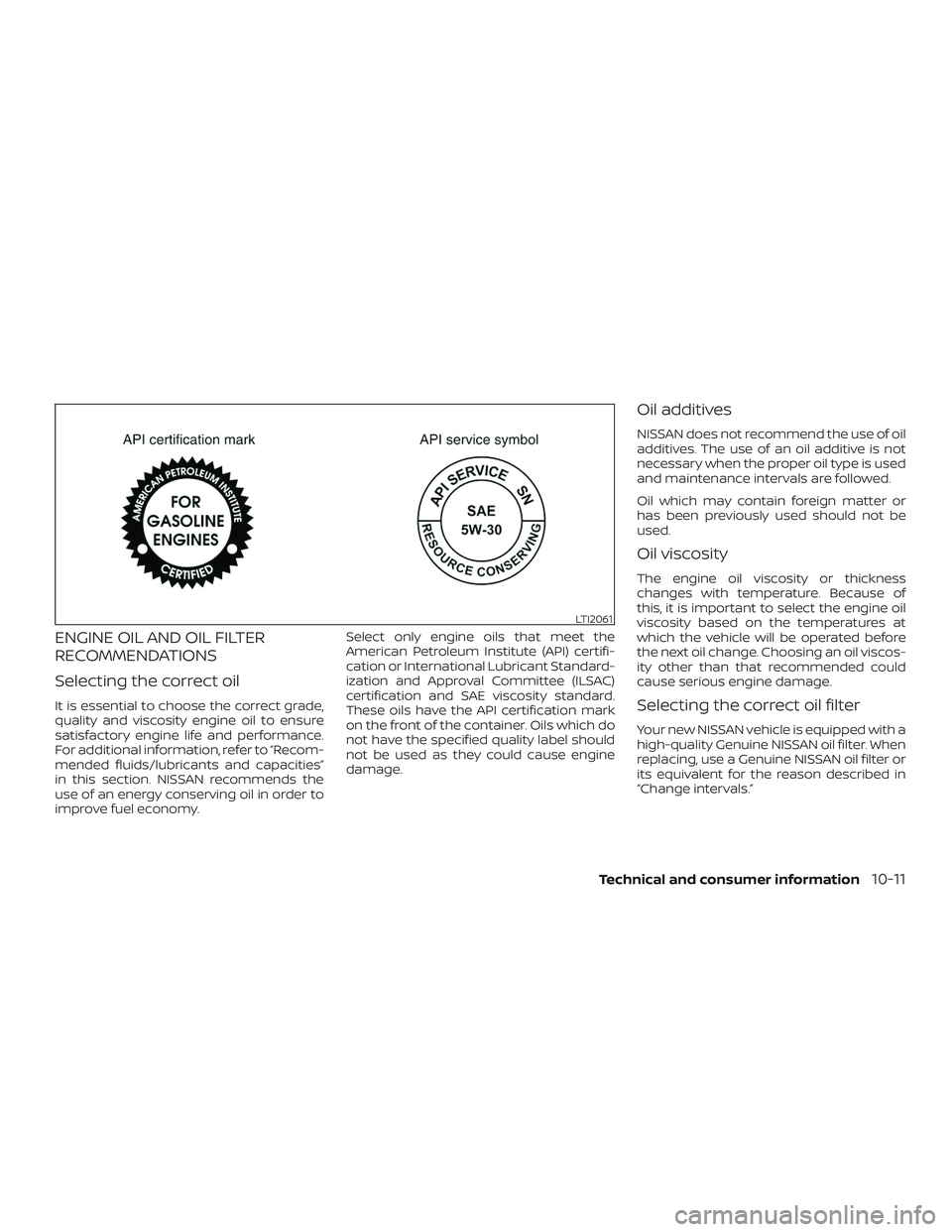
ENGINE OIL AND OIL FILTER
RECOMMENDATIONS
Selecting the correct oil
It is essential to choose the correct grade,
quality and viscosity engine oil to ensure
satisfactory engine life and performance.
For additional information, refer to “Recom-
mended fluids/lubricants and capacities”
in this section. NISSAN recommends the
use of an energy conserving oil in order to
improve fuel economy.Select only engine oils that meet the
American Petroleum Institute (API) certifi-
cation or International Lubricant Standard-
ization and Approval Committee (ILSAC)
certification and SAE viscosity standard.
These oils have the API certification mark
on the front of the container. Oils which do
not have the specified quality label should
not be used as they could cause engine
damage.
Oil additives
NISSAN does not recommend the use of oil
additives. The use of an oil additive is not
necessary when the proper oil type is used
and maintenance intervals are followed.
Oil which may contain foreign matter or
has been previously used should not be
used.
Oil viscosity
The engine oil viscosity or thickness
changes with temperature. Because of
this, it is important to select the engine oil
viscosity based on the temperatures at
which the vehicle will be operated before
the next oil change. Choosing an oil viscos-
ity other than that recommended could
cause serious engine damage.
Selecting the correct oil filter
Your new NISSAN vehicle is equipped with a
high-quality Genuine NISSAN oil filter. When
replacing, use a Genuine NISSAN oil filter or
its equivalent for the reason described in
“Change intervals.”
LTI2061
Technical and consumer information10-11